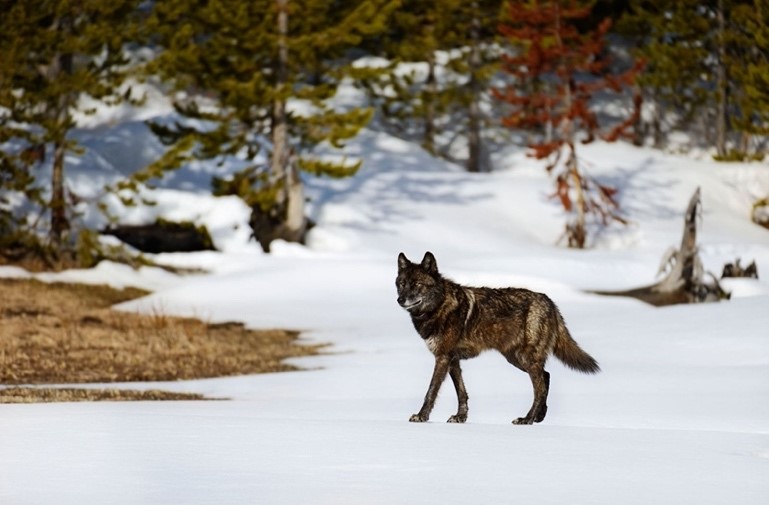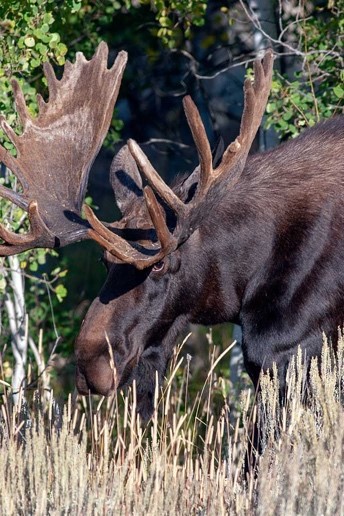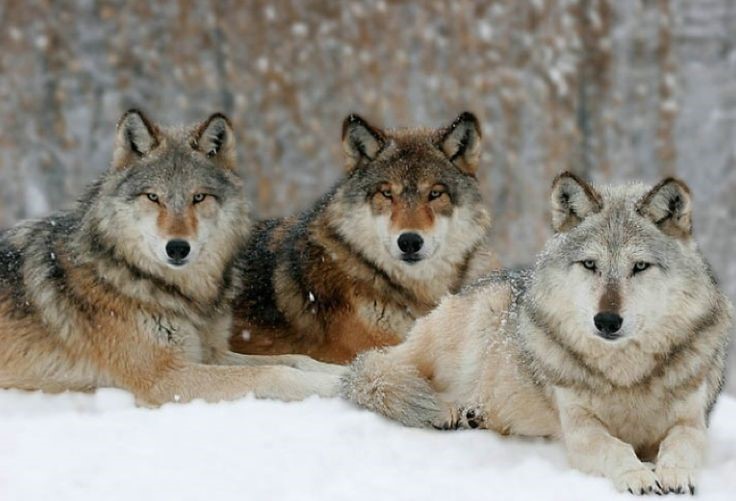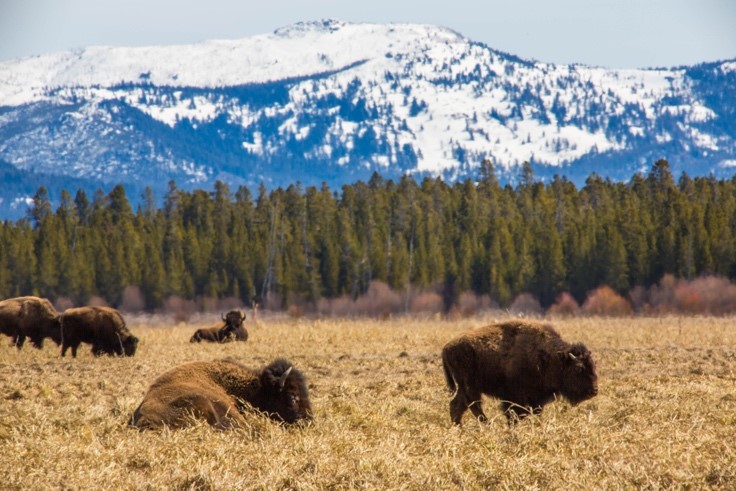The reintroduction of 14 wolves in Yellowstone during the 1990s brought many benefits to an ecosystem that deteriorated almost 80 years of their absence.1 This is what we call a Quantum Ecological Miracle (QEM).

The return of the wolves restored Yellowstone's natural balance.
(Photo: https://www.muchbetteradventures.com/magazine/yellowstone-wolves-rewilding-1995-history-books/)
The balance in nature is delicate. A change in the structure of an ecosystem can generate several inconveniences. The disappearance and reintroduction of wolves in Yellowstone National Park, in the United States, is an example of this. In the early twentieth century, wolves were dramatically hunted within Yellowstone park and its surroundings, until they were eliminated. In 1926, the last gray wolf of Yellowstone was killed and then the imbalance began.2

Wolves were reintroduced to Yellowstone in 1996. (Photo: https://www.quotemaster.org/balance+of+nature)
The populations of species that were controlled by wolves began to grow excessively. One of them, the moose, became practically a pest within the limits of Yellowstone park.
The damage from the absence of wolves in Yellowstone
As there were no carnivores, the increase in herbivores caused serious damage to the vegetation. Such was the situation, that in the 60s the administration of Yellowstone Park enabled and pushed the hunting of moose to try to contain its growth.

The overpopulation of moose destroyed the vegetation of Yellowstone in the twentieth century. (Photo by https://www.kruzanphotography.com/kruzanphotography/yellowstone-national-park-wy-moose-2005/)
By the 70s it was thought that the situation was under control and that the moose plague had already subsided, so hunting was stopped. Over time, moose began to overpopulate the park again and the same problem happened. Hunting would no longer be an action to control and balance Yellowstone's ecosystem. That is why, in 1995, U.S. environmental authorities decided to reintroduce initially 14 gray wolves to the park.

The wolf packs readapted to the environment. (Photo: https://survivallife.com/yellowstone-wolves/)
Wolf packs adapted to the environment and reproduced. Over time, they managed to control the moose that destroyed the vegetation of the park. The behavior of moose changed. The moose stopped grazing always in the same places, especially on the shores of the rivers. The shrubs that tried to develop there began to grow remarkably, changing the landscape and benefiting other species.
Bears, pumas, and bison returned with the wolves
Birds that feed on the seeds of the park's plants began to roam Yellowstone again. In addition, while the moose population began to decrease, the population of grizzly bears (a subspecies of brown bears) also began to grow.3

Brown bears were the main beneficiaries of the wolves return to Yellowstone. (Photo: https://www.goodfreephotos.com/united-states/wyoming/yellowstone-national-park/brown-bear-yellowstone-national-park-wyoming.jpg.php)
Researchers at the universities of Washington and Oregon found that overgrazing of moose also caused damage to the availability of food for brown bears. Due to the predation of wolves, there began to be more availability of red fruits, which is what bears consume to gain weight before hibernation. Thus, the decimated population of brown bears in Yellowstone was balanced and over time grew. Since the arrival of the wolves in 1995, another benefit was also recorded within Yellowstone: the pumas began to repopulate the park, also accompanied by vultures and bison.

Bison also benefited from wolves. (Photo: https://www.explorebigsky.com/government-agencies-to-cull-up-to-900-yellowstone-bison)
The reintroduction of wolves in Yellowstone is today considered one of the great and successful ecological experiments of recent years. The effects it had on the balance of life in the park surprised many researchers. It is also an example of how a man-made imbalance, such as the killing of wolves, can have serious consequences for an entire ecosystem.
After almost 100 years wolves can call Yellowstone park “home”. Through this Quantum Ecological Miracle (QEM), we can see how keystone species and trophic structures play a crucial role in community dynamics. Because we need this information to carry out successful reintroduction operations and effectively restore natural habitats for them to be sustainable in the future, we must comprehend all levels of the food chain and analyze the intricate trophic interactions that occur between them. We place a high value on efforts to restore and safeguard our beautiful ecosystems.
This Quantum Ecological Miracle (QEM) recalls some ideas referred to quantum mechanics, that deal with microscopic, atomic, and even subatomic particles. We highlight the importance of these small particles in macroscopic processes that happen in our daily life, in nature, at home and even in our bodies. Recent research suggests that a wide range of organisms may use quantum mechanics' unique properties to their advantage. Birds use it. A toaster machine, a fluorescent light, computers, mobile phones, biological compasses, transistors, lasers, GPS, and magnetic resonance devices are some examples of the manifestation of the small particles that produce such remarkable effects. In the same way, the QEM described above, points out how actions or numbers that seem small can produce big effects. It is in that sense that our multidisciplinary international team has developed a tool denominated The "Quantum Leap to Green Action (QLGA)" which aims to engage the public in a broader sustainability mission, and offers an opportunity to impact society in general and promotes commitment to action against climate change.
If we mention Climate change actions, it is necessary to mention the China Biodiversity Conservation and Green Development Foundation (CBCGDF) which is involved in conservation efforts in several ways. It has engaged the conservation work at the community level through its Community Conservation Areas (also called CCAfa) having to date over 100 CCAfas in China.4 On the other hand, the Andean Road Countries for Science and Technology (ARCST), has launched, with the collaboration of several international academic and research institutions the first declaration on Science Literacy of Latin America, which aims to promote the Science Culture Construction (SCC) focused on the biodiversity protection and the green development. Based on this declaration, a series of academic activities have taken place to further implement the actions to develop the SCC.
CBCGDF as well has launched several educational initiatives to raise awareness of environmental issues inside China to encourage sustainable practices. CBCGDF works with schools and with a large network of wildlife volunteers through local initiatives in target areas. Its scientific staff is engaged in research and management plans in reserve wildlife habitats across the country. It also advises industry and government bodies on sustainable development and environmental impacts for their projects in several cities in China.
Recently, Prof. Zhou Jinfeng, the Secretary-General of CBCGDF proposed to the public an innovative approach to " Biodiversity Conservation in our Neighborhood", also known as BCON.5,6 BCON aims to explore the best practices of effective biodiversity conservation in areas with intensive human activities, give consideration to conservation and development, and coordinate sustainable livelihoods and biodiversity conservation. BCON aims to promote the effective conservation of biodiversity in areas where human activities are intensive, to balance conservation and development, and to synergize sustainable livelihoods and biodiversity conservation. Traditional conservation of biodiversity is mainly carried out in deep mountains, natural wilds, and nature reserves. Although this kind of landscape conservation is also very important, the current efforts are far to reverse the global trend of rapid biodiversity loss.
Climate change today represents a crisis in which man is losing the game; his fight has not been enough to stop the negative impacts on the planet. We are witnessing more and more catastrophic effects and fewer quantum miracles. Because the conservation of biodiversity, green development, energy efficiency, CO2 emissions reduction require innovative thinking, it is of great importance to learn how to effectively carry out biodiversity conservation in populated areas. That is why CBCGDF and ARCST, together with Universidad Central del Valle del Cauca in Colombia, Universidad Privada del Valle in Bolivia, UNESCO Media and Information Literacy (MIL), Professors from different countries around the world from France, Benin, South Africa, Cameroon, Iran, Kazakhstan, Indonesia, Bolivia, Pakistan, Turkey, Iran and several others, have decided to go one step forward and develop a tool that can be used wherever we are and go and contribute to biodiversity conservation, green development and several of the sustainable development goals (SDG’s goals) through the “Quantum Leap to Green Action” (QLGA).7,8
QLGA can bring us closer to new paradigms of thought that encourage human beings to adopt behaviors in favor of climate change, reducing greenhouse gas emissions sustainably and cost-effectively to fulfill several SDG’s goals.
QLGA in the family would begin by listening to the ideas of its members, especially children and young people, these ideas would continue to be communicated to distant members in meetings or through social networks and finally, the cycle would be closed with the wisdom of the ancestors that complement that legacy so important that it helps QLGA actions into the collective conscience.
QLGA through educational institutions includes a journey that begins with classmates, advances through teachers and continues through managers. The starting point will be those environmental projects that originate in the imagination of each group of students based on the results of the QLGA in the family, under the concept of innovation laboratories identifying needs and proposals associated with the SDGs. These laboratories take advantage of the knowledge that the ancestors have left in the new generations and adjust to local environments to promote dialogue with citizens and the territory. The professors contribute their specialized knowledge to formulate the projects and the directives support these initiatives with their influences in the local regions.
QLGA around the world integrates the wills of all the countries that make each idea a reality, taking them to societies and especially vulnerable populations to raise awareness towards a better, sustainable, lasting, resilient world that defends the life of all species.
CBCGDF has partnerships and international collaborations with several international environmental groups such World Wildlife Fund (WWF), United Nations Environment Programme (UNEP), United Nations Development Programme (UNDP), the Convention on Biological Diversity (CBD), the Convention on Migratory Species (CMS), CITES and the International Union for Conservation of Nature (IUCN). In 2016, it signed a partnership agreement with the Convention of Migratory Species (CMS) making it the first Chinese organization to partner with the CMS. Together with ARCST, UCEVA, UNESCO MIL, UNIVALLE and several other institutions are ready to implement the Quantum Leap to Green action across geographic borders and language barriers.
We believe that the celebration of the World Green Science Day (WGSD)13-15 on December 9th, is an excellent and exceptional opportunity to join representatives of different countries, among which borders and distances no longer exist. Offering delegates the chance to discuss about their experience in promoting actions that favor green development and biodiversity conservation. We expect that this opportunity will challenge the academic community to take on new perspectives, and build strong new friendships that span across the globe. The event plans to be inspirational, through our guest speaker sessions and scintillating topics, that will help our future leaders to develop the International Green Science Academy Network (IGSAN)16 and transform their ideas into actions through the Quantum Leap to Green action (QLGA). The “South-South Biodiversity Science Project (SSBSP)” proposed by the “China Conservation and Green Development Foundation (CBCGDF)”,17 in conjunction with the “Green Science Project (GSP)”18 proposed by the “Andean Road Countries for Science and Technology (ARCST)” have created a framework of cooperation19 for the implementation of the Science Culture Construction (SCC) as the foundation to develop the scientific cause to build a community with a shared future for mankind.
References
1 https://www.restauraciondeecosistemas.com/como-los-lobos-cambiaron-el-curso-del-rio-yellowstone/
2 https://eresciencia.com/los-lobos-de-yellowstone/
3 https://www.ecocultura.com/lobos-en-yellowstone-retorno-equilibrio-naturaleza/
4 https://www.gbif.org/dataset/1b26c417-366a-4eb0-a212-6ee8035d83fb/project
5. http://www.cbcgdf.org/English/NewsShow/5007/21398.html
6. https://www.overshootday.org/portfolio/biodiversity-conservation-neighborhoods-cbcgdf/
7. http://z.cbcgdf.org/nd.jsp?id=580&_sc=3@Mark
8. http://z.cbcgdf.org/nd.jsp?id=579&_sc=3@Mark
11. https://weibo.com/5327744144/MfrMn32BD
12. https://weibo.com/5327744144/MfrOw3yeN
15. https://journalasc.org/2022/11/17/the-world-green-science-day-for-and-with-society-09-12-2022-concept-note/
18. https://journalasc.org/2021/08/13/scientific_literacy_gsp_1/
19. https://journalasc.org/society-information/
Our multidisciplinary team is composed by:
Prof. Zhou Jinfeng, Secretary General of China Biodiversity Conservation and Green Development Foundation. Prof. Marco A. Cabero Z., Deputy Secretary South South Biodiversity Science Project (SSBSP), China Biodiversity Conservation and Green Development Foundation (CBCGDF). President of the Andean Road Countries for Science and Technology. Linda Wong, Deputy Secretary of China Biodiversity Conservation and Green Development Foundation. Prof. Sylvain Eimer, Beihang University. Prof. Jose Gabriel Perez, Universidad Central del Valle del Cauca. Prof. Mary Luz Ojeda S., Universidad Central del Valle del Cauca. Prof. Desire Wade Atchike, Taizhou University. Prof. Edgar Ramos, Universidad Privada del Valle. Prof. Jorge Ruiz de la Quintana, Universidad Privada del Valle. And the liaison officers of the Andean Road Countries for Science and Technology (ARCST) Luan Henrique, Brazil. Shabahat Hasain Qamar, Pakistan. Kiara Mahadev, South Africa. Satyam Agrawal, India. Indah, Indonesia. Wendy Gu, China. Jamenna Raynon, Philippines. Andam Andin Ndi, Cameroon. Vahid Rasti Nasab, Iran. And the collaboration of Zhao Yanyan, Yvonee Li, Longliang Jiang, Zhang Xiaoxin, Shao Xiaoting, Wang Xinsheng and Wu Chao.
